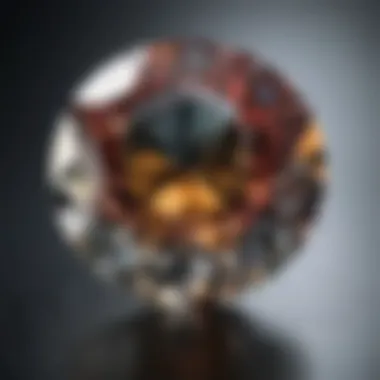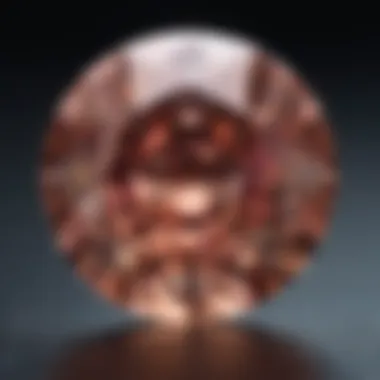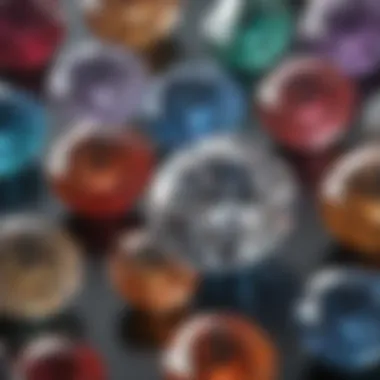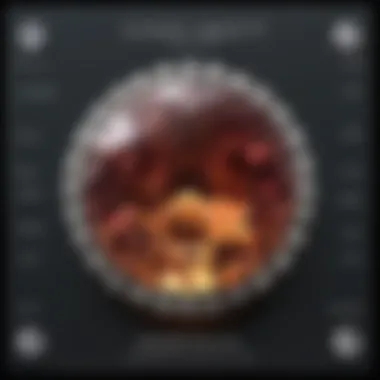Unveiling the Intricacies of Diamond Cut, Clarity, and Color Chart


Overview of Gemstones and Minerals
Diamonds, as exquisite gems, hold a special place in the realm of gemstones and minerals. Their allure and elegance are unmatched, making them highly sought-after treasures. The history of diamonds dates back centuries, where they symbolized wealth, power, and eternal love. In various cultures and societies, diamonds have been revered for their beauty and significance.
Gemstone Formation and Properties
Understanding the formation process of diamonds provides insight into their unique properties. Diamonds are formed deep within the Earth's mantle under immense pressure and high temperatures. The process of crystallization over millions of years results in the creation of these dazzling gemstones. The properties that define diamonds include their exceptional hardness, brilliance, and clarity, coupled with a stunning array of colors.
Types of Gemstones
In the realm of gemstones, diamonds are classified as precious gems due to their rareness and exceptional beauty. Contrary to popular belief, diamonds are not the only gemstones. Semi-precious gemstones, such as emeralds, rubies, and sapphires, also captivate with their elegance. The world of gemstones extends beyond the conventional, embracing exotic and rare varieties that intrigue and fascinate gemstone enthusiasts worldwide.
Identifying and Evaluating Gemstones
Evaluating a diamond involves considering various factors that impact its value. The 4Cs - cut, clarity, color, and carat weight - play a crucial role in determining a diamond's quality. Techniques like magnification and fluorescence are often used to identify and assess diamonds. Understanding the significance of these factors is essential for evaluating the quality and authenticity of gemstones.
Caring for Gemstones
Proper care and maintenance are vital for preserving the brilliance of diamonds. Cleaning diamonds regularly with mild soap and water helps maintain their sparkle. Proper storage, away from other jewelry that can scratch them, prolongs their luster. Avoiding common mistakes such as exposure to harsh chemicals or sudden temperature changes safeguards the integrity of diamonds. Gemstone preservation tips vary based on the specific gem types, necessitating tailored care routines for different gemstones.
Introduction to Diamonds
Diamonds have long captivated humankind with their unrivaled beauty and rarity. In this article, we embark on a journey delving into the enchanting realm of diamonds, with a specific focus on the critical aspects of cut, clarity, and color that define their brilliance and value. Understanding diamonds is not merely about their physical structure but also about appreciating the meticulous craftsmanship that goes into unlocking their hidden splendor.
Formation of Diamonds
The formation of diamonds is a fascinating process that unfolds deep within the Earth's mantle. Over millions of years, intense heat and pressure transform carbon into the mesmerizing crystals we adore. This natural alchemy results in diamonds of extraordinary durability and radiance, each bearing a unique story of its time in the Earth's embrace. From volcanic eruptions to tectonic shifts, the journey of a diamond from the depths of the Earth to sparkling adornment is a testament to nature's awe-inspiring power.
Overview of Diamond Properties


Diamonds are renowned not only for their hardness but also for their exceptional optical properties. With a high refractive index and dispersion, diamonds exhibit unparalleled brilliance and fire, making them a top choice for jewelry connoisseurs. The ability of diamonds to reflect and refract light in a dazzling display sets them apart from all other gemstones. Understanding these fundamental properties is key to evaluating and selecting the perfect diamond that captures one's heart.
Significance of Cut, Clarity, and Color
The cut, clarity, and color of a diamond are paramount in determining its value and allure. The precision with which a diamond is cut enhances its ability to reflect light, creating breathtaking sparkle and radiance. Clarity, on the other hand, refers to the presence of internal or external flaws that can affect the stone's brilliance. Lastly, the color of a diamond, ranging from colorless to vivid shades, adds a unique character to each gem. Mastering the significance of cut, clarity, and color equips one with the knowledge to appreciate and discern the intricacies of these prized gemstones.
Understanding Diamond Cut
When delving into the realm of diamonds, one cannot overlook the paramount importance of understanding diamond cut. The cut of a diamond not only influences its visual appeal but also plays a crucial role in determining its brilliance and fire. In the context of this article, understanding diamond cut becomes a focal point due to its direct impact on the overall beauty and value of a diamond. By comprehending the facets of diamond cut, readers gain a deeper appreciation for the intricate craftsmanship involved in enhancing a diamond's allure.
Importance of Cut in Diamond Evaluation
In the intricate evaluation process of diamonds, the aspect of cut holds significant weight. The cut of a diamond is a key factor that determines how effectively light is reflected and refracted within the gemstone, ultimately affecting its sparkle and brilliance. A well-cut diamond not only accentuates its natural beauty but also maximizes its optical properties, creating a captivating visual experience. Understanding the importance of cut in diamond evaluation empowers individuals to make informed decisions when selecting and appreciating diamonds of exceptional quality.
Types of Diamond Cuts
- Round Cut:
Round Cut:
The round cut diamond stands out for its timeless elegance and exceptional brilliance. Its symmetrical shape and precise faceting contribute to its mesmerizing sparkle, making it a popular choice for various jewelry pieces. The round cut's ability to reflect light optimally enhances its scintillation, setting it apart as a classic and versatile option in the world of diamonds.
- Princess Cut:
Princess Cut:
A princess cut diamond is characterized by its square shape and sharp, uncut corners, giving it a distinctive and modern appearance. This cut's unique faceting style allows for heightened sparkle and brilliance, making it a preferred choice for individuals seeking a contemporary yet timeless diamond design.
- Emerald Cut:
Emerald Cut:


Known for its step-cut faceting and elongated shape, the emerald cut diamond exudes sophistication and refinement. This cut emphasizes clarity and exhibits a hall-of-mirrors effect, creating a mesmerizing play of light within the gemstone. The emerald cut's architectural beauty and elegant simplicity make it an esteemed choice for those appreciating a tasteful and understated diamond look.
- Astrel Cut:
Astrel Cut:
The astrel cut diamond presents a captivating blend of traditional and modern elements, featuring a unique mix of step-cut and brilliant-cut facets. This innovative cut enhances the diamond's brilliance and scintillation, offering a balance between classic sophistication and contemporary allure. The astrel cut's intricate facet pattern adds a captivating dimension to the gemstone, making it a distinctive choice for individuals seeking a diamond cut that stands out from the crowd.
Factors Affecting Diamond Cut Quality
Deciphering Diamond Clarity
Diamond clarity holds a pivotal role in the realm of gemstones, especially when assessing the quality and value of diamonds. Understanding and decoding the intricacies of a diamond's clarity can provide invaluable insights into its formation and history. By scrutinizing the internal flaws, or inclusions, and external imperfections, known as blemishes, a gemologist can evaluate a diamond's transparency and brilliance. Deconstructing diamond clarity involves a meticulous examination of these imperfections under magnification to determine its clarity grade, ranging from 'Flawless' to 'Included.' Delving deep into this aspect illuminates the uniqueness and identity of each diamond, imparting a deeper appreciation for its rarity and beauty.
Defining Diamond Clarity
To define diamond clarity is to dissect the purity of a diamond by inspecting the presence of inclusions and blemishes that affect its overall appearance. Inclusions refer to internal flaws, such as minerals or fractures, while blemishes pertain to external marks like scratches or chips. The clarity grade assigned to a diamond reflects the size, number, position, and nature of these imperfections. A 'Flawless' diamond exhibits exceptional clarity with no visible inclusions or blemishes under 10x magnification, while an 'Included' diamond possesses noticeable imperfections that may impact its brilliance. Understanding the definitions and distinctions within diamond clarity categories is vital for discerning buyers and enthusiasts seeking to unearth the true essence of a diamond's purity.
Grading Scale for Diamond Clarity
The grading scale for diamond clarity serves as a universal language for evaluating and comparing diamonds based on their purity and brilliance. Developed by gemological institutions like the Gemological Institute of America (GIA), the scale ranges from 'Flawless (FL)' to 'Included (I)' with various subcategories in between. Each clarity grade corresponds to a specific level of inclusions and blemishes visible under magnification, guiding buyers in making informed decisions about diamond quality. Familiarizing oneself with this scale empowers individuals to navigate the intricate world of diamond clarity, enabling them to appreciate the nuances of imperfection and the impact it has on a diamond's value and allure.
Exploring Diamond Color Chart
In the vast realm of diamonds, the understanding of color holds a pivotal position. The Exploring Diamond Color Chart segment within this article encapsulates the essence of hues in diamonds, showcasing their impact on overall beauty and value. As gemstone enthusiasts delve into the intricacies of diamond evaluation, the significance of color becomes apparent in determining rarity and desirability of these precious stones.
Understanding Diamond Color Grading
Understanding Diamond Color Grading is a fundamental aspect within the realm of diamonds. This process involves assessing the absence of color or the presence of subtle hues within a diamond, crucial in determining its quality and value. The grading scale provides a standardized method for gemologists and buyers to communicate the color characteristics observed, ranging from colorless to light yellow or brown hues. By comprehending diamond color grading, individuals can make informed decisions when selecting diamonds that meet their preferences and standards.
Factors Influencing Diamond Color


Numerous factors come into play when assessing the color of diamonds. The presence of trace elements during formation, such as nitrogen or boron, can influence the diamond's color profile. Additionally, external factors like light conditions and surroundings can impact how the color of a diamond is perceived. The cut of a diamond also plays a critical role in reflecting light and enhancing or diminishing its inherent color. Understanding these factors provides a deeper insight into the complexities of diamond color assessment.
GIA Color Scale
The Gemological Institute of America (GIA) Color Scale is a globally recognized standard for diamond color evaluation. This scale classifies diamonds from D (colorless) to Z (light yellow or brown), each grade representing a distinct hue level. The GIA Color Scale ensures consistency and accuracy in assessing diamond color across the industry, guiding buyers and dealers in understanding and communicating the intricate variations in diamond color. Familiarizing oneself with the GIA Color Scale equips individuals with the knowledge to navigate the diamond market effectively, facilitating informed decisions based on standardized color classifications.
Interplay of Cut, Clarity, and Color
As we embark on our exploration of the interplay of cut, clarity, and color in the realm of diamonds, the significance of this trio in determining the beauty and value of a diamond comes to the forefront. These three elements act as the pillars upon which the brilliance and allure of a diamond rest, each playing a crucial role in defining its aesthetic appeal and overall quality. Understanding how the cut, clarity, and color interact harmoniously can elevate one's appreciation for these dazzling gemstones.
When delving into the interplay of cut, clarity, and color, it becomes evident that each facet contributes uniquely to the diamond's visual splendor. The cut, with its precision and craftsmanship, dictates the diamond's ability to reflect and refract light, enhancing its sparkle and fire. Clarity, on the other hand, ensures the transparency and purity of the diamond, indicating the presence or absence of inclusions and blemishes. Lastly, the color of a diamond adds another layer of depth, ranging from icy whites to rich yellows or even rare fancy hues, imbuing the stone with character and personality.
In our exploration, we unravel the complexities of how these elements interact synergistically, affecting the diamond's overall beauty. The interplay between cut, clarity, and color is not just about individual characteristics but also about their combined effect on the diamond's appearance. Finding the ideal balance between these factors is essential to unlock the full potential of a diamond, maximizing its brilliance and allure.
Achieving Diamond Brilliance Through Optimal Cut, Clarity, and Color
As we seek to achieve diamond brilliance through optimal cut, clarity, and color, it is imperative to understand the profound impact that each of these factors has on the stone's beauty. The cut of a diamond, often referred to as its 'make,' is decisively crucial in determining its sparkle and brilliance. A well-cut diamond allows light to enter through its crown and reflect back through the top, creating a mesmerizing play of light and color.
Similarly, diamond clarity plays a pivotal role in enhancing its brilliance by ensuring that light can flow through the gem unimpeded. Diamonds with higher clarity grades are prized for their transparency and purity, as they allow for maximum light performance. When combined with an optimal cut that maximizes light return, a diamond's brilliance is magnified, resulting in a scintillating display of sparkle.
Moreover, the color of a diamond adds a distinctive touch to its brilliance, influencing its overall appearance and character. While colorless diamonds are traditionally favored for their classic elegance, colored diamonds showcase a unique and enchanting beauty. By carefully balancing the cut, clarity, and color of a diamond, one can unlock its full potential, witnessing a breathtaking radiance that captivates the beholder.
Balancing Factors for the Perfect Diamond
In the quest for the perfect diamond, striking a harmonious balance between various factors is paramount. Achieving the ideal combination of cut, clarity, and color requires meticulous attention to detail and a deep understanding of how each element contributes to the diamond's overall appeal. While a superior cut can enhance a diamond's brilliance, it must be complemented by exceptional clarity to ensure a flawless visual experience.
Balancing these factors involves making thoughtful choices that align with one's preferences and priorities. Whether prioritizing a specific diamond shape, a particular clarity grade, or a preferred color intensity, each decision impacts the final outcome of the diamond's beauty. By carefully weighing these factors and their interplay, one can tailor the search for the perfect diamond to suit individual tastes and aesthetics.
Ultimately, the quest for the perfect diamond is a nuanced journey that involves considering a myriad of factors to achieve a harmonious balance of cut, clarity, and color. By understanding the interplay between these elements and how they contribute to a diamond's brilliance, one can navigate the intricate world of diamonds with confidence and appreciation for their extraordinary beauty.
Conclusion
Exploring the diamond cut, clarity, and color chart is crucial for anyone seeking to understand the complexities of evaluating diamonds effectively. In this article, we have meticulously dissected the intricate world of diamonds, emphasizing how cut, clarity, and color play pivotal roles in determining a diamond's quality and beauty. The significance of this exploration lies in providing gemstone enthusiasts, collectors, jewelry designers, and geology enthusiasts with valuable insights into the criteria that define a diamond's worth and allure. By delving deep into these factors, readers can develop a profound appreciation for the art and science behind evaluating diamonds.
Key Takeaways on Diamond Cut, Clarity, and Color
When exploring diamond cut, clarity, and color, several key takeaways emerge that are essential for anyone interested in gemstones. The cut of a diamond is paramount, impacting its brilliance and fire, making it a vital aspect to consider when selecting a stone. Clarity, on the other hand, reflects the presence of imperfections within the diamond, influencing its overall purity and value. Lastly, the color of a diamond is crucial, with colorless stones being the most desirable. Understanding these elements is fundamental for assessing a diamond's quality and ensuring that it aligns with individual preferences and requirements. By grasping the interplay between these factors, one can make informed decisions when purchasing or appreciating diamonds.







